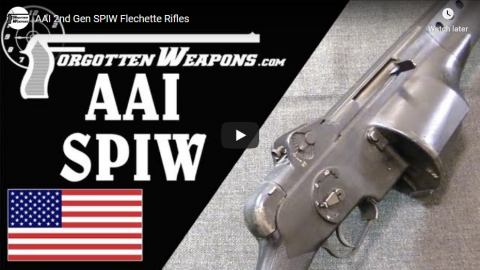Forgotten Weapons
Published on 7 Aug 2019http://www.patreon.com/ForgottenWeapons
Cool Forgotten Weapons merch! http://shop.bbtv.com/collections/forg…
Designed in an effort to compete with the then-new Colt/Browning air cooled 1895 machine gun, the Extra-Light Maxim weighted in at just 27 (maybe 28) pounds for the gun, and 44 pounds with tripod. This may sound heavy, but it was a remarkable improvement over the 100+ pounds of most models of Maxim with mount. The water jacket was replaced with an air jacket (necessary to support the muzzle), and the whole gun was narrowed. The mainspring was moved to the inside of the receiver, allowing lighter construction but complicating disassembly and removing the ability to tune the mainspring tension to fit a particular batch of ammunition.
The concept proved to be a commercial failure, as the air cooling lacked the sustained fire capability that militaries were looking for. A total of 135 examples were made, but most were sold in small orders for testing, with no major contracts forthcoming.
Many thanks to the Royal Armouries for allowing me to film this tremendously rare artifact! The NFC collection there – perhaps the best military small arms collection in Western Europe – is available by appointment to researchers:
https://royalarmouries.org/research/n…
You can browse the various Armouries collections online here:
https://royalarmouries.org/collection/
Contact:
Forgotten Weapons
PO Box 87647
Tucson, AZ 85754
September 26, 2019
Hiram’s Extra Light Maxim Gun
September 20, 2019
Huot: Canada’s Ross-based Prototype Automatic Rifle from WW1
Bloke on the Range
Published on 18 Jul 2019Patreon: https://www.patreon.com/BlokeOnTheRange
Due to a shortage of Lewis guns and a glut of withdrawn Ross Mk.III rifles once the Canadian Expeditionary Force had been completely re-equipped with Lee-Enfield SMLE rifles, Monsieur Huot proposed to modify Ross rifles into an automatic rifle / light machine gun (LMG) configuration.
5 of these are known to exist, this is number 2, and is in the Seaforth Highlanders of Canada museum in Vancouver: https://www.seaforthhighlanders.ca/ho…
Many thanks to them for the opportunity to handle and film this exceptionally rare piece! Please give them a visit!
September 17, 2019
From Bolt Action Lee to LMG: The Charlton Automatic Rifle
Forgotten Weapons
Published on 26 Jul 2019http://www.patreon.com/ForgottenWeapons
Cool Forgotten Weapons merch! http://shop.bbtv.com/collections/forg…
The Charlton automatic rifle is one of very, very few examples of a conversion from bolt action to self-loading rifle actually working reasonably well. Typically this sort of project founders in expense and unreliability. Charlton, however, was able to take his vision for providing the New Zealand Home Guard with a new weapon made form obsolete surplus and bring it fully to fruition, with 1500 guns made. They were never fired in anger, but allowed New Zealand to put all of its Bren guns into the field while retaining the Charltons as emergency weapons in case of Japanese invasion. Sadly, virtually all were destroyed in a warehouse fire after the war, leaving them extremely rare today.
Many thanks to the Royal Armouries for allowing me to film and disassemble this very scarce automatic rifle! The NFC collection there – perhaps the best military small arms collection in Western Europe – is available by appointment to researchers:
https://royalarmouries.org/research/n…
You can browse the various Armouries collections online here:
https://royalarmouries.org/collection/
For the whole detailed story on Charlton manufacture, and to download a copy of the manual, check my web site article here:
https://www.forgottenweapons.com/light-machine-guns/charlton-automatic-rifle/
Contact:
Forgotten Weapons
PO Box 87647
Tucson, AZ 85754
September 14, 2019
How Does It Work: Lever Delayed Blowback
Forgotten Weapons
Published on 11 Jul 2019http://www.patreon.com/ForgottenWeapons
Cool Forgotten Weapons merch! http://shop.bbtv.com/collections/forg…
Lever-delayed blowback is a relatively uncommon action system, although it is applicable to a wide variety of firearms and has been successfully used in submachine guns, rifles, and light machine guns. It uses a principle of mechanical disadvantage on a fulcrum lever to force a mass to accelerate rearward while the bolt remains closed. This allows the effective weight of the moving parts to be amplified, resulting in a lighter firearm.
Contact:
Forgotten Weapons
PO Box 87647
Tucson, AZ 85754
September 13, 2019
Why You Wouldn’t Want to Fly The First Jet Airliner: De Havilland Comet Story
Mustard
Published on 1 Dec 2017Air travel before the Jet Age wasn’t always glamorous. The relentless noise and vibration from a piston powered propeller aircraft often made long flights even more exhausting. Most aircraft also couldn’t fly high enough to avoid bad weather, so air sickness was more common.
After World War Two, as part of an effort to develop its civil aviation industry, Britain stunned the world by unveiling the world’s first jet airliner. The de Havilland Comet was sleek, quiet, and flew higher and faster than any airliner of the day. As piston propeller technology was reaching its limits, the conventional thinking was that jet engines were too unreliable and produced too little power relative to their fuel consumption. But the de Havilland Comet proved that jet travel was the future. When the Comet entered service in 1952, it immediately began breaking travel time records and became a point of national pride for Britain.
The de Havilland Comet was perhaps little too ahead of its time. With such a clean sheet design, there were still lessons to learn. When early Comets suffered from catastrophic depressurization incidents, the entire fleet was grounded and their Certificate of Airworthiness was revoked. Flaws in the design of the aircraft’s fuselage were resolved in later Comet versions. However, the rest of the world was now catching up, and manufacturers including Boeing and Douglas began to offer their own jet airliners. While later version Comets served airlines reliably, they were outsold by competing aircraft. There’s no question However, that the comet paved the way. The British had taken a massive risk and brought the world into the jet age. #DeHavilland #CometAirliner #Airplane
Want to help Mustard grow? Support us on Patreon: https://www.patreon.com/MustardChannel
August 31, 2019
General Motors Diesel: The Modern Power (1937 and 1942)
PeriscopeFilm
Published on 6 May 2016Support Our Channel: https://www.patreon.com/PeriscopeFilm
First made in 1937 by General Motors and then repackaged for the WWII war effort, DIESEL THE MODERN POWER tells the story of the development and principles of the diesel engine. The film uses live action and animation to show how the diesel engine works, and live action footage of Sherman tanks, streamlined locomotives, switching engines, ships, and more.
The film begins with an historical overview that includes a brief lesson on how to make fire, including two stones, rubbing pieces of wood, and even the “fire syringe” that was used by the people of Southeast Asia. The syringe is used to demonstrate the operation of a piston in an engine.
At 14:30, 600 hp diesel engine are seen at the Century of Progress Exposition in Chicago. At 14:46, the Burlington Pioneer Zephyr is seen running from Chicago to Denver. Mainline passenger locomotives are seen, providing up to 6000 hp. Diesel switch engines are seen at the 15:30 mark.
At 18:40, lumber equipment, oil pumps, and earth moving equipment are seen — all driven by diesel engines.
The Detroit Diesel works is seen at the 19 minute mark. Diesel powered submarines, mine sweepers and coast patrol boats as well as fleet tugs, are also seen.
A two-stroke diesel engine is a diesel engine that works in two strokes. A diesel engine is an internal combustion engine that operates using the Diesel cycle. Invented in 1892 by German engineer Rudolf Diesel, it was based on the hot-bulb engine design and patented on February 23, 1893. During the period of 1900 to 1930, four-stroke diesel engines enjoyed a relative dominance in practical diesel applications. Charles F. Kettering and colleagues, working at the various incarnations of Electro-Motive and at the General Motors Research Corporation during the 1930s, advanced the art and science of two-stroke diesel technology to yield engines with much higher power-to-weight ratios than the two-stroke diesels of old. This work was instrumental in bringing about the dieselisation of railroads in the 1940s and 1950s.
All diesel engines use compression ignition, a process by which fuel is injected after the air is compressed in the combustion chamber, thereby causing the fuel to self-ignite. By contrast, gasoline engines utilize the Otto cycle, or, more recently, the Atkinson cycle, in which fuel and air are mixed before entering the combustion chamber and then ignited by a spark plug.
August 23, 2019
Sterling S11: Donkey in a Thoroughbred Race
Forgotten Weapons
Published on 26 Jun 2019http://www.patreon.com/ForgottenWeapons
Cool Forgotten Weapons merch! http://shop.bbtv.com/collections/forg…
In the 1960s, the Sterling company began to worry about the prospects of continued sales of the Sterling (Patchett) SMG, especially in light of new competitors like the H&K MP5. Its chief design engineer, Frank Waters, created the S11 as a gun to replace the classic Sterling. The S11 was based on a simple stamped/folded steel receiver, and was intended to have a lower unit cost than the Sterling. It kept the excellent Patchett magazine, but had a barrel and sights offset to the left side, and offered two separate bayonet lugs – one for the No5 rifle and one for the L1A1/FAL.
Unfortunately for Sterling, it was determined that the tooling cost would have made the S11 actually more expensive than the existing guns, whose tooling costs had been long since covered. Also, the S11 was just not a very good or very reliable design – a “donkey in a thoroughbred race” to quote one Sterling manager. This one prototype was the only example ever made, and the project was shelved in 1967 in favor of expanding into more civilian models of the original Sterling.
Many thanks to the Royal Armouries for allowing me to film and disassemble this one of a kind submachine gun! The NFC collection there – perhaps the best military small arms collection in Western Europe – is available by appointment to researchers:
https://royalarmouries.org/research/n…
You can browse the various Armouries collections online here:
https://royalarmouries.org/collection/
Contact:
Forgotten Weapons
PO Box 87647
Tucson, AZ 85754
August 18, 2019
AAI 2nd Gen SPIW Flechette Rifles
Forgotten Weapons
Published on 24 Jun 2019http://www.patreon.com/ForgottenWeapons
Cool Forgotten Weapons merch! http://shop.bbtv.com/collections/forg…
The SPIW program began in 1962 with entries from Colt, Springfield, AAI, and Winchester. The first set of trials were a complete failure, and both Colt and Winchester abandoned the project at that point. AAI pressed on, producing these second generation rifles – one for trials in 1966 and one after. Both are chambered for the XM-645 5.6x57mm single-flechette cartridge. Under testing, both showed multiple serious problems in reliability, noise, cook-offs, and accuracy. The company would struggle on for years continuing to develop the flechette rifle system, but would be ultimately unsuccessful.
Thanks to the Rock Island Arsenal Museum for allowing me access to film this very interesting rifle! If you are in the Quad Cities in Illinois or Iowa, the Museum is definitely worth a visit. They have a great number of small arms on display as well as an excellent history of the Rock Island Arsenal.
http://www.arsenalhistoricalsociety.o…
Contact:
Forgotten Weapons
PO Box 87647
Tucson, AZ 85754
August 15, 2019
How Does it Work: Stoner’s AR System
Forgotten Weapons
Published on 18 Jun 2019http://www.patreon.com/ForgottenWeapons
Cool Forgotten Weapons merch! http://shop.bbtv.com/collections/forg…
Eugene Stoner’s AR-10 and AR-15 use an operating mechanism that is often called “gas impingement,” but which is actually a cleverly structured gas piston located within the bolt carrier. Gas is tapped from the barrel and moved all the way back to just behind the chamber, where it enters the bolt carrier. There the carrier and bolt act as the two parts of a sealed piston, and when the bolt carrier moves rearward the cam pin forces the bolt head to rotate and unlock. The expanding gas is then vented out through holes in the side of the bolt carrier. By locating the piston on the same axis as the barrel, the harmonics are improved and the overall weight of the gun can be reduced by using the gas piston elements as mass in the bolt carrier assembly. Contrary to the old adage “it shits where it eats,” the operating gasses are not vented into the magazine or chamber, and the system has proven to be very reliable.
Contact:
Forgotten Weapons
PO Box 87647
Tucson, AZ 85754
August 6, 2019
How Does it Work: Gas-Delayed Blowback
Forgotten Weapons
Published on 11 Jun 2019http://www.patreon.com/ForgottenWeapons
Cool Forgotten Weapons merch! http://shop.bbtv.com/collections/forg…
Gas-delayed blowback is a relatively uncommon operating system used in handguns. It is not an efficient mechanism for high-pressure rifle power cartridges, but works well with something like 9mm Parabellum. It tends to provide benefits of light felt recoil and better-than-average accuracy, in exchange for overheating much more quickly than other systems.
Contact:
Forgotten Weapons
PO Box 87647
Tucson, AZ 85754
August 3, 2019
Polish PM63 Rak at the Range
Forgotten Weapons
Published on 8 Jun 2019http://www.patreon.com/ForgottenWeapons
Cool Forgotten Weapons merch! http://shop.bbtv.com/collections/forg…
Whether it is described as a machine pistol, a submachine gun, or a personal defense weapon, the PM63 Rak is really not the best examples of this sort of thing to actually shoot. The open-bolt/slide mechanism is very cool from an engineering and design perspective, but does in fact have a tendency to hit one in the face, as inadvertently demonstrated by my high-speed video shooting volunteer. Even if it doesn’t do that, the sights reciprocating on the slide make it a difficult gun to shoot accurately.
Thanks to Movie Armament Group in Toronto for giving me the opportunity to take this to the range! Check out MAG on Instagram: https://instagram.com/moviearmamentsg…
Contact:
Forgotten Weapons
PO Box 87647
Tucson, AZ 85754
August 2, 2019
PM63 Rak: An Interesting Polish SMG/PDW Hybrid
Forgotten Weapons
Published on 7 Jun 2019http://www.patreon.com/ForgottenWeapons
Cool Forgotten Weapons merch! http://shop.bbtv.com/collections/forg…
The PM-63 Rak is a pretty interesting Polish Cold War machine pistol or personal defense weapon. It fires from an open bolt, but uses a slide like a pistol rather than a bolt in an enclosed receiver like a typical SMG. There are several other interesting elements to the design, so let’s take a closer look…
Thanks to Movie Armament Group in Toronto for giving me the opportunity to bring you this video! Check out MAG on Instagram: https://instagram.com/moviearmamentsg…
Contact:
Forgotten Weapons
PO Box 87647
Tucson, AZ 85754
August 1, 2019
Maxim “Prototype”: The First Practical Machine Gun
Forgotten Weapons
Published on 31 Jul 2019http://www.patreon.com/ForgottenWeapons
Cool Forgotten Weapons merch! http://shop.bbtv.com/collections/forg…
Hiram Maxim was the first person to create a truly practical and functional machine gun, based on a patent he filed in 1883. He pioneered the recoil operating system – the concept of harnessing the recoil generated by a firearm to perform the actions of reloading that firearm. His patent was based on a lever action rifle, but his intent was to create a machine gun, complete with belt feed and water cooling. After a testbed “forerunner” gun, he built this model which he called the “Prototype”. It was meant as a proof of concept, and used in many public exhibitions and demonstrations.
The Prototype used a hydraulic rate of fire control system which could be set as high as 500 rounds/minute and as low as just one round per minute. The gun did not have a trigger as we would recognize it today, but rather a single lever like a vehicle accelerator which acted as both trigger and fire rate control. Only three of these Prototypes exist today, with one belonging to the USMC, one on public display at the Royal Armouries museum in Leeds, and this one in the NFC reserve collection at Leeds.
For a fantastic exploded view of all this guns working parts, check out this work by YouTube channel vbbsmyt:
Many thanks to the Royal Armouries for allowing me to film this tremendously important artifact! The NFC collection there — perhaps the best military small arms collection in Western Europe — is available by appointment to researchers:
https://royalarmouries.org/research/n…
You can browse the various Armouries collections online here:
https://royalarmouries.org/collection/
Contact:
Forgotten Weapons
PO Box 87647
Tucson, AZ 85754
July 31, 2019
The Jaguar E-Type / XK-E Story
Big Car
Published on 10 May 2019To help me continue producing great content, please consider supporting me: https://www.patreon.com/bigcar
The Jaguar XK-E or E-Type may be the most beautiful car in history. It’s certainly one of the most sought after, with cars fetching crazy prices at auction. It’s a car born out of a Le Mans-winning heritage, delivering looks with speed and handling to match, all at an affordable price. Yet somehow it had a top speed over 150mph, while also not having a top speed over 150mph!
#JaguarEType #JaguarXKE #EType
July 23, 2019
How Does It Work: Direct Gas Impingement
Forgotten Weapons
Published on 21 May 2019Interested in small arms history? Make sure to pre-order a copy of my book, Chassepot to FAMAS: French Military Rifles 1866 – 2016:
https://www.kickstarter.com/projects/…
Direct gas impingement is an operating system that has been used only in a few production guns (all of them rifles). It is extremely simple, although perhaps not well suited to adjustability. It is also not the operating system of the AR series of rifles – we will cover those in a separate video.
http://www.patreon.com/ForgottenWeapons
Cool Forgotten Weapons merch! http://shop.bbtv.com/collections/forg…
Contact:
Forgotten Weapons
PO Box 87647
Tucson, AZ 85754


















